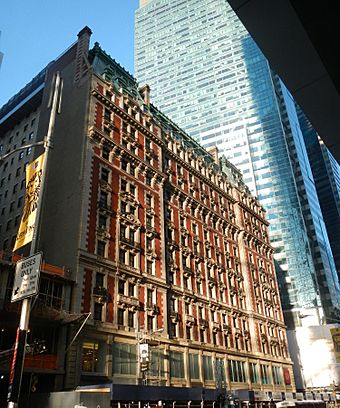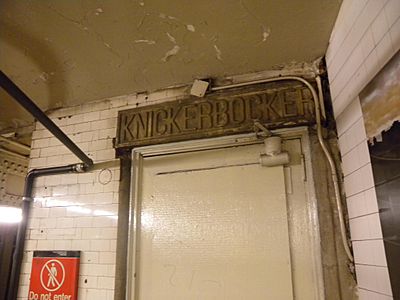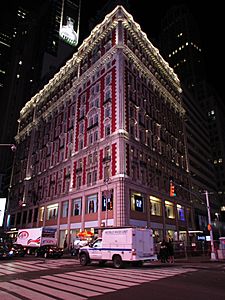The Knickerbocker Hotel facts for kids
|
The Knickerbocker Hotel
|
|

Seen from beside the Bank of America Tower on 42nd Street, 2012
|
|
| Location | 142 West 42nd Street New York, NY 10036 |
|---|---|
| Area | ~ 300,000 square feet (28,000 m2) |
| Built | 1901 or 1906 |
| Architect | Trowbridge & Livingston; Marvin & Davis; Price, Bruce |
| Architectural style | Beaux Arts |
| NRHP reference No. | 80002697 |
Quick facts for kids Significant dates |
|
| Added to NRHP | April 11, 1980 |
The Knickerbocker Hotel is a hotel located at the southeast corner of Broadway and 42nd Street in Times Square, Manhattan, New York City. The name "Knickerbocker" is an iconic Dutch surname associated with New York City. Prominent longtime residents of the hotel included Enrico Caruso and George M. Cohan. Built by John Jacob Astor IV (1864–1912) as a showcase of luxury in a time of prosperity, the hostelry closed 15 years later because of financial decline.
The hotel was converted to offices in 1920 and was known as The Knickerbocker Building. It was the home of Newsweek magazine (1940–59) and became the Newsweek Building. After major renovations in 1980 it became known as 1466 Broadway and was used for many years as garment showrooms and offices. During this period it was later known as 6 Times Square. It was converted back to use as a hotel in 2013–15 under its original name.
The building is in the Beaux-Arts style, constructed of red brick with terracotta details and a prominent mansard roof. The architects were Marvin & Davis, with Bruce Price as consultant, and it was placed on the National Register of Historic Places in 1980 and designated a New York City Landmark in 1988.
History
Original hotel
A Philadelphia development group organized by J.E. and A.L. Pennock financed the construction of the hotel starting in 1903 on land owned by John Jacob Astor IV. The Pennocks hired architects Bruce Price and Marvin & Davis to design the French Renaissance-style building. One year later, in February 1904, the investment group that sponsored the developers collapsed and the building was left incomplete, with the exterior complete but housing just an empty shell. In May 1905, Astor assumed control of the project and engaged Trowbridge & Livingston, who had just designed his St. Regis Hotel, to complete the interiors.
The Knickerbocker opened October 23, 1906, and quickly became a part of the New York social scene. The $3.3 million hotel contained 556 rooms and luxurious restaurants and bars on the first three floors with seating for 2000 for after-theater dinner. Artist Maxfield Parrish was commissioned to paint a 30-foot-long mural of Old King Cole for the bar. Frederic Remington, Frederick MacMonnies and James Wall Finn also added decorations to the interiors. The bar became so popular that it was nicknamed "The 42nd Street Country Club".
The martini was said to have been invented by the hotel's house bartender in 1912. According to the story, one Martini di Arma di Taggia mixed dry vermouth and gin together and the mixture gained the favor of John D. Rockefeller. (In reality, Rockefeller was a lifelong abstainer from alcohol and tobacco. The actual origin of the martini has been traced to a different drink called "the Martinez".)
The world-famous opera singer Enrico Caruso was a longtime resident of the hotel until it was sold in 1920. He usually took all his meals at the hotel restaurant, always using the same set of cutlery. On Armistice Day, Caruso appeared at the window of his room and led the crowd outside in singing "The Star-Spangled Banner". He once gave his overcoat to a cold, homeless man on the sidewalk outside the hotel.
After John Jacob Astor IV died on the Titanic in 1912, his son Vincent Astor inherited the hotel. It continued to run successfully under James B. Regan, its operator since opening, until 1920, when Regan retired and surrendered his lease. Prohibition, enacted the year before in 1919, had impacted upon the hotel's business in its restaurants and bars, and Vincent decided to close the hotel and convert the structure into an office building.
Office use
Vincent Astor hired architect Charles A. Platt to design the conversion. The luxury hotel interiors were completely gutted and the ground levels were converted to stores, while the rest of the building was rebuilt as an office building, with rents from $4 to $5 per square foot, approximately $60 per square foot in 2013. The Old King Cole painting was loaned for a time to the Racquet and Tennis Club on Park Avenue, before being installed permanently at the St. Regis Hotel in 1935. The building became home to Newsweek magazine from 1940 to 1959 and was known as the Newsweek Building.
By the 1970s, the building was operated by a group headed by businessman Harry Helmsley. When Helmsley announced that he would drop his ownership of the Knickerbocker Hotel building in 1975, this raised concerns that the building would be demolished. The other option was to renovate the space for $2 million, which could then be rented for $4.50 per square foot ($48.4/m2). In 1980, with the office market in a slump, Helmsley and David Baldwin converted the office building to residential lofts, with the name 1466 Broadway. However the commercial market quickly recovered and the residential units were instead rented as showrooms and studios for companies in the Garment District. The building was listed on the National Register of Historic Places on April 11, 1980.
Reuse as hotel
In 2004, SL Green sold the building, by then known as 6 Times Square, to Sitt Asset Management, which in turn sold the building in 2006 to Istithmar Hotels, an investment group from the Royal family of Dubai. Istithmar announced plans to convert the building back into a five-star hotel, but they were unable to fulfill their debt obligation and surrendered the property to their lender in early March 2010.
In early February 2012, FelCor Lodging Trust, a U.S. Real estate investment trust, acquired the building at a cost of $115 million. FelCor renovated the property for an additional $115 million, completely gutting it, with the exception of the historic facade, and converting it to a modern 330-room hotel. The project was designed by Peter Poon Architects. The hotel reopened on February 12, 2015, under its original name, The Knickerbocker Hotel. It offers 300 rooms, including 27 Junior Suites and 4 Signature Suites. It also features a restaurant, a coffee shop and a roof bar overlooking Times Square.
A sign for the hotel can be found in the New York City Subway's Times Square station. The "Knickerbocker" sign is posted over a doorway that once connected to the hotel at the east end of the platform for Track 1 on the 42nd Street Shuttle.
Gallery
See also
 In Spanish: The Knickerbocker Hotel para niños
In Spanish: The Knickerbocker Hotel para niños








